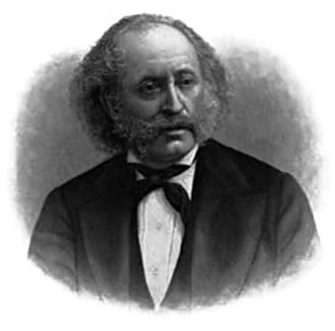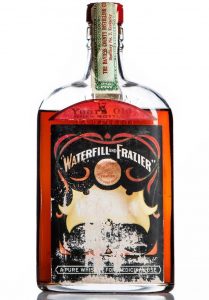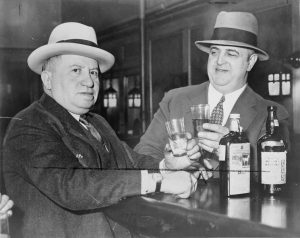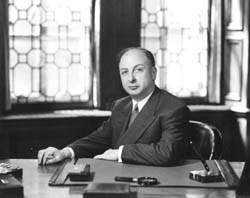I’ll be presenting my talk “My Cup Runneth Over,” all about the history of Jews and alcohol, live in Jerusalem on Sunday, July 25. So as a little teaser, this post will explore in a bit more detail something I’ll only have time to address in passing during the talk.
(And if you’re in Jerusalem, and want to join, please register. Also, I’m planning a trip to the States in October/November for a speaking tour. If you’d like me to come present this, or another of my Food Talks in your community, please be in touch!)
But the point of this post specifically is to discuss the Jewish experience during American Prohibition (1920-1933). Common wisdom would say the main connection of Jews to Prohibition would be as bootleggers — those who illegally made or sold alcohol during this period. As is so often the case, common wisdom is wrong, or at least presents a highly oversimplified interpretation of the facts. Without question, there were many Jewish bootleggers. However, Jews were also prominent in supporting Prohibition, fighting against it legally or even operating with legal means to supply and/or drink alcohol at the time.
Pre-Prohibition Era American Jews
In Jews and Booze: Becoming American in the Age of Prohibition (a primary, though not sole source for this post), Marni Davis explains how immigrant Jews had become disproportionately represented in the American alcohol production and sales industries. Thus, it is not surprising to hear that, by and large, most Jews were opposed to the temperance movement. (Prohibition — the outlawing of alcohol consumption — was just the culmination of a broader movement of temperance, designed to get people to stop drinking, either voluntarily or by legal means.) It represented a direct blow to their business interests! But there was more to that opposition than simple financial considerations.

Furthermore, while Jews regularly drank (including wine every Shabbat, four cups at the Passover Seder, many celebrations that had drinks to accompany them, and also moderate amounts of simple recreational drinking), they also famously had no serious problem with alcoholism or abuse. Thus, they saw temperance not only as an attack on their religious practices, but felt their own case proved that the problem lay with the drinkers, not with the drink. In his fervent attacks on the temperance movement, Reform Rabbi Isaac Mayer Wise held Jews up as examples of how one could still drink but choose to do so responsibly with moderation. He saw the WCTU as religious tyrants, and those who opposed them as the defenders of constitutional liberties.
The Law and its Loopholes
Even before the Volstead Act prohibited alcohol in 1920, the 1913 Webb-Kenyon Act began the legal march towards total Prohibition. And already, Jews started looking for legal loopholes. The Jacobs brothers (Joseph, Hyman and Edward) spread out between three different southern states and shifted their existing alcohol business into mail-order, for home consumption. This was perfectly in keeping with the criteria outlined in Webb-Kenyon, and it allowed them to take advantage of a tough and changing scenario. Their success would later be echoed in many case by others who, rather than flouting the law, found ways to exploit weaknesses and (sometimes enormous) loopholes within it.

The biggest loophole by far, however, was the one featured in the photo at the top of the post — Sacramental Purposes. Knowing the law would be struck down in court if it prevented religious observance, the Volstead Act formalized the protection of using alcohol for ritual needs. Of course, this did not apply only to Jews; wine forms a central element in Christian mass, as well. So the sacramental exemption was extensively used (and at time illegally exploited) by Christians as well. But the main difference between Jewish and Christian religious use of alcohol was its context. Christian religious alcohol consumption took place as part of the church service, while Jewish ritual use typically took place in the home, at a Sabbath meal with the family, for example. This made enforcement much more difficult.
Further complicating enforcement was the decentralized, and little understood (by the government) religious organization of Jews, as well as the procedure by which one became a rabbi. There was no single organization to which all rabbis, synagogues or practicing Jews belonged, nor even a handful. This created a scenario that was rife with opportunities for shadier people to take advantage. Many synagogues reported massive membership increases — even up to tenfold increases — shortly after Prohibition began. This was not due to increased religious zeal, but because sacramental wine was distributed via synagogues based on their memberships. Furthermore, there was even non-Jews who banded together to form their own “Jewish congregation,” headed by a Rabbi O’Malley or Chan.
As the 1920s wore on, the Prohibition authorities found ways to close down the abuse of this loophole without eliminating it entirely. Along the way, however, there were a number of high-profile arrests or court cases of Jews (including rabbis) who allegedly abused this loophole to circumvent the law, rather than work within its bounds.
Mobsters and Agents, Both
There were, of course, many in America who blatantly flouted the law, rather than trying to exploit its weaknesses. Actual bootleggers and rum runners were not remotely hard to find in the US during the Prohibition years. And yes, a number of them were Jewish, though not as many as many think. And plenty of Jews were also active on the opposite side.

This in no way detracts from the prominence of some infamous Jewish mobsters in the bootlegging trade. Meyer Lansky, for example, is one of the more notorious examples, involved with illegally importing liquor from Canada (more on that later). So much alcohol crossed south in Lake Erie that some referred to it as the “Jewish Lake.” Davis says that of gangsters involved in bootlegging, 50% were Jewish, thus disproportionately high within this single segment of bootleggers.
Still, Jews were also amongst the most prominent in fighting against these mobsters. Izzy Einstein and Moe Smith were the two most successful Prohibition agents in the beginning of the era, racking up nearly 5,000 arrests and confiscating about 5 million bottles of alcohol. Their methods were colorful, often using disguises (including drag) or foreign languages. Their unlikely and dramatic success brought them fame, not necessarily to the liking of the agency they worked for. But the public ate up the exploits of Prohibition Agent No. 1 (and 2).
The Bronfmans
Much of the alcohol that was brought from Canada to the U.S. during prohibition was supplied by Sam Bronfman and his family, the owners of Seagram’s distillery. Arriving to Canada from Bessarabia (present day Moldova) in 1889, the family ended up settling in Western and Central Canada, only later moving to Montreal. Starting in the hotel industry, they parlayed that success into alcohol sales during Canada’s own short-lived World War I era of Prohibition. Much like the Jacobs brothers, they were always careful to stay within the bounds of the law, also using a local mail-order loophole at first.

Still, Sam Bronfman was often referred to as “the last bootlegger,” a term that Faith believes he would have hated. He always sought respectability via his alcohol sales, and was quite proud of operating within the law (and thus not being a bootlegger). Even during American Prohibition, with increased shipments across the border into the U.S., Bronfman was following the law. As a Canadian judge put it at the time, “There is no burden cast upon us to enforce the laws of the United States.”
Making the business larger and of a much higher quality during Prohibition, Sam was poised for success directly in America following Repeal in 1933. He was excellent at marketing, understood the pulse of the people, and had become an artist at blending whiskeys. He took advantage to make consumption of quality liquor into a respectable act of discerning taste in post-Prohibition America.
The Legacy
All of these different sides to Jews during Prohibition actually made them a microcosm of society at the time. There was no universal opinion, and neither widespread acceptance or law-breaking. As Davis points out, “American Jews participated in the illegal alcohol trade during Prohibition for many of the same reasons as did other Americans: it was potentially lucrative, even in modest quantities; the law was inadequately enforced and relatively easy to evade; and Prohibition was viewed by many Americans as a joke and an inevitable failure, which lessened the stigma of breaking the law. While many regarded Jewish bootlegging as proof that Jews were incapable of conforming to American values, one might instead regard it as evidence of Jewish acculturation, since the flouting of Prohibition law was practically a national pastime.”
Still, those Jews who did break the law brought antisemitic attacks, though these were also exacerbated by the non-Jews who exploited the Jewish sacramental wine loophole for their own purposes. Faith wrote that a haunting legacy for the Bronfman family is that, despite their largely operating legally, “the terms ‘bootlegger’ and ‘Jew’ had become interchangeable.” One of the most notorious antisemites to pick up alcohol-related activities as a means of attacking the Jews was Henry Ford. He bought a newspaper solely to print his anti-Jewish articles and essays, many focusing on this subject, and later compiled them into his infamous book The International Jew: The World’s Foremost Problem.
Such attacks on bootleggers clearly grew out of pre-existing antisemitic sentiments, rather than bootlegging activities generated those sentiments. As mentioned, Jews were actually underrepresented among bootleggers. On top of that, there were even some Jews who, seeing the problems that were heading their way, were willing to forego the sacramental wine exemption. Reform Rabbi Stephen S. Wise (no relation to Isaac Mayer Wise) supported Prohibition from a pragmatic standpoint, and suggested closing the loophole. He also posited that unfermented grape juice was equally acceptable for religious purposes, an opinion that others later agreed with.
In the end, the story of Jews during Prohibition is just one of many interesting elements of the much larger history of Jews and alcohol. In this short period, though, we see quite an array of intersections with the issue, on all sides and from all perspectives. In this way, the events not only summarize the mix of the Jewish people at the time, but also the culmination of many trends in the modernization of the Jewish nation.
I hope you’ll join me, if you’re in Israel, at my talk on Jews an Alcohol. It will cover a wider array of topics in less depth, rather than this post that went very deep on a single topic.







De la gravuri somptuoase la schițe cu bețișoare, ouăle de Paște – și arta lor – au evoluat de secole. - Acoinking.com
[…] au existat îndoieli cu privire la reclamele la alcool la doar cinci ani de la Interdicție, când vinul sacramental era greu de găsit, Haggadah a lui Schapiro a susținut „valorile de sănătate” ale vinului. Pe două pagini de […]
From sumptuous engravings to stick-figure sketches, Passover Haggadahs − and their art − have been evolving for centuries - NFL Bulletin
[…] in case there were any doubts about advertising alcohol a mere five years after Prohibition, when sacramental wine was difficult to access, Schapiro’s Haggadah made the case for wine’s “health values.” Across two pages at the back […]
From magnificent engravings to stick-figure sketches, the Passover Haggadahs—and their art—have evolved over the centuries - USA NEWS LIVE
[…] in case there have been doubts about alcohol promoting just five years after Prohibition The sacramental wine was difficult to accessSchapiro’s Haggadah advocated for the “health values” of wine. In two pages at the top of the […]
Passover Haggadahs − and their art − have been evolving for centuries – Ur1stop blog
[…] in case there were any doubts about advertising alcohol a mere five years after Prohibition, when sacramental wine was difficult to access, Schapiro’s Haggadah made the case for wine’s “health values.” Across two pages at the back […]
Passover Haggadahs − and their art − have been evolving for centuries – Truth Latest News | Um-ma
[…] in case there were any doubts about advertising alcohol a mere five years after Prohibition, when sacramental wine was difficult to access, Schapiro’s Haggadah made the case for wine’s “health values.” Across two pages at the back […]